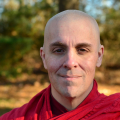Please help me learn about how walking meditation is taught across tradition/sect in Buddhism
 BhikkhuJayasara
Bhikkhu Veteran
BhikkhuJayasara
Bhikkhu Veteran
Friends,
Those of you who have read my posts for the past few years know I am big on walking meditation, it essentially changed my practice, and my life. I’m interested in learning all I can regarding how(and if) walking meditation is taught across tradition. So regardless of what tradition/sect you hail from, if you do walking meditation I’d love to find out more about that.
Eventually if specific teachers/tradition names are mentioned I’d like to speak to them directly about the methods taught.
So in the post below if you’d be so kind to answer some of these basic questions it would be appreciated. Please be as specific as you feel appropriate.
Buddhist Tradition/Sect :
Sub-tradition/country/ sect(if any) :
Specific to teacher? please name :
Goal of walking meditation as taught :
Focus during walking meditation(feet/breath, etc, ) :
Speed (very slowly, normal walking pace, etc) :
Recommended Path Length :
In relation to other postures (i/e is it used as an equal partner to other postures and a serious practice or just a way of stretching for when your feet fall asleep etc) :
Any relevant websites/books/youtube videos you can give to me that explains the process or anything you’d like to add that I may of missed:



Comments
In the Soto Zen tradition Kinhin is the extension of the stillness of zazen into the action of walking. This is the more essential meaning of walking meditation- it brings the strength of meditation into the everday act of walking and it provides physical relief without breaking the stillness of Zazen.
It is also symbolic of the Buddha’s walking round and round the bodhi-tree following his enlightenment. So it likewise represents your ‘wandering about in the world of enlightenment’, in the words of Dogen-Zenji, the founder of Soto Zen Buddhism, for the first time.
When doing kinhin, walk clockwise around the room (zendo), holding your hands in shashu (Hands and arms: formal- make a fist around the thumb, palm-down at heart level. The other hand over fist, press together gently. Forearms and elbows at same height, parallel to floor.) position. From the waist up, your posture should be the same as that in zazen - Upper body: keep erect, attention in the tanden(abdomen), gaze fixed down.. Take the first step with your right foot. Advance by taking only half step for each full breath (one exhalation and inhalation).
Walk slowly and smoothly as if you were standing in one place. Do not drag your feet or make noise. Walk straight ahead, and when turning, always turn to right. The word kinhin means to go straight. When you finish kinhin, stop and bow. Then walk at a normal pace around the room until you return to your seat.
http://global.sotozen-net.or.jp/eng/practice/zazen/howto/
Buddhist Tradition/Sect : Tibetan Buddhism and I guess Kagyu and Nyingma tradition.
Sub-tradition/country/ sect(if any) : UK
Specific to teacher? please name : Lama Shenpen Hookham (knowledgeable/approved of the Mahamudra teachings; her teacher is Khenpo Gyamptso Tsultrim Rinpoche)
Goal of walking meditation as taught : Bridge between sitting and 'daily awareness'(sati or smirti)
Focus during walking meditation(feet/breath, etc, ) : body sensations. Can add senses too but without ideation or telling yourself stories (eg I wonder if that bird sees a cat? etc). Rest in openness of heart and space of mind and notice senses. Focus used to bring yourself back from when your attention wanders in thoughts. As practice develops can deepen into letting go into the fundamental space of awareness beyond concepts as done in formless sitting meditation.
Speed (very slowly, normal walking pace, etc) : Slow motion or at normal speed.
Recommended Path Length : Can be outdoors or indoors going back and forth or in circles and depends on the amount of space you have.
In relation to other postures (i/e is it used as an equal partner to other postures and a serious practice or just a way of stretching for when your feet fall asleep etc) : Is a bridge between Daily Awareness (sati/smirti) and Formless Sitting meditation. In sitting you don't have to balance and walk and get so much sense information (particularly if walking outdoors). So the idea is to go deep into resting the mind while at the same time you have more body/sense information.
Any relevant websites/books/youtube videos you can give to me that explains the process or anything you’d like to add that I may of missed:


One thing that may be of interest to explore is walking in Tai Chi. This is done slowly with great emphasis on the weight transfer, non swaying, non telegraphing of movement etc. It is not taught as meditation but is done at a similar pace, I remember one teacher who spent several lessons teaching us to walk before going on to the Tai Chi form.
Personally I have found it useful to practice at aprox. five times slower than normally taught in Buddhist schools. Really as slow as one can whilst still moving. This gives an insight into the very subtle muscle, ligament movements.
I have also used mindful speed walking with attentive mindfulness.
Also of interest might be the lung gong pa trance walkers

and tendai marathon monks
https://en.m.wikipedia.org/wiki/Kaihōgyō
I was taught walking meditation by Lama Tony Duff (he has a FB page that he is fairly active on).
I am a Tibetan Nyingma practitioner, but my teacher doesn't specifically teach walking meditation. Our local sangha hosts teachers from other traditions sometimes, and Lama Tony was one of them. Learning walking meditation, even in circles around the room, was life-changing, as you said @Jayantha. I am not sure if Lama Tony has a particular sect, I cannot recall. He was a student of Chogyam Trungpa, but he has been living in Nepal for many years and does a lot of work with translating teachings.
Anyhow, to try to answer some of your other questions:
Focus during walking meditation(feet/breath, etc, ) : More so an overall focus. Bringing oneself inward, but awareness of everything else as well. I would say focus was more on the foot placement but that was my experience and I don't recall being told to focus on them. There was quite a bit of focus during the teaching part about holding the hands in front of the navel.
Speed (very slowly, normal walking pace, etc) : Very slowly, with an emphasis of feeling how the feet contact the ground inch by inch as you set the foot down and lift off.
Recommended Path Length : None, more so based on time similar to sitting. Recommended to do before sitting, or if you cannot settle your mind for sitting.
In relation to other postures (i/e is it used as an equal partner to other postures and a serious practice or just a way of stretching for when your feet fall asleep etc) : It wasn't described as a "lesser" meditation but it was clear that it should not replace sitting. It was introduced as a way to increase mindfulness of the body and the world around.
Any relevant websites/books/youtube videos you can give to me that explains the process or anything you’d like to add that I may of missed:
This is the most similar to how I was taught, except we hold our hands at our navel, Right hand cupping the left hand.
I feel kind of silly answering this one because I do my own version or adaptation based on all I've read, listened to and watched of walking meditation along with trial and error.
Thich Nhat Hanh and Pema Chodron were the largest influence but more the ideas behind the walking and not so much the formalities. I would not wish to tarnish their names by linking my practice with them.
The goal for me is usually either to just feel and relax into the stillness amidst the movement or to blend a contemplative state into non-thinking awareness where labels don't apply.
Basically I use the same variations as I do for sitting meditation such as stillness or various Metta exercises (I even close my eyes sometimes which is probably not the best thing).
I don't have too much of a formal approach and just go with the flow so to speak. Not too slow and not too fast but those designations vary depending on things like my mood or health.
I sometimes focus on my breath, sometimes my pace and sometimes I focus on nothing in particular using the breath or footfalls as a mental buoy. When I use them as buoys I focus on them until I have my rhythm back and gently phase them out.
Using them as buoys represents the raft we are using which we may have to one day abandon to reach the far shore.
Sorry, this is not a great example of what you were asking for but it's an example at least.